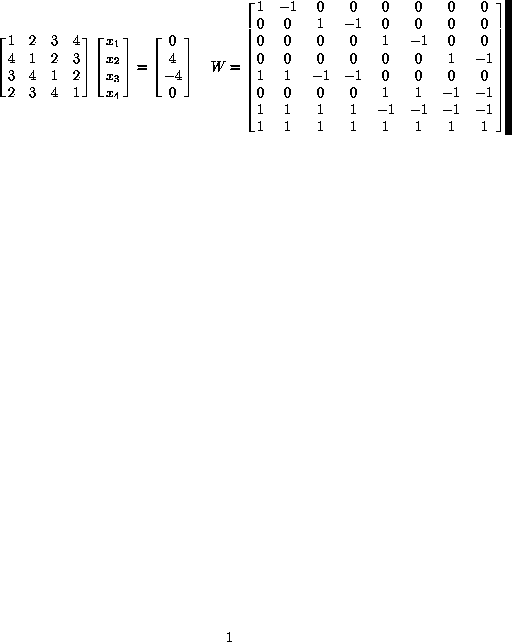EECS 658_________________________PROBLEM SET #7_________________________Fall 1999
ASSIGNED: Nov. 11, 1999. READ: HANDOUTS: Levinson and Schur algorithms, Book chapter.
DUE DATE: Nov. 18, 1999. THIS WEEK: Levinson and Schur, wavelet matrix sparsification.
We wish to solve the linear system of equations
[x1,x2,x3,x4]C=[0,4,-4,0] (see below)
where C is a circulant matrix whose first row is [1,4,3,2] (see below for C transposed).
- Solve this linear system of equations using the 4-point DFT.
- Use the 2-point DFT to solve the general 2×2 circulant system of equations.
A 0-mean WSS process has covariance R(k)=0.7071|k|[6cos((pi)k/4)+2sin((pi)|k|/4)].
- Set up the extended Yule-Walker equations for computing the 3rd-order
autoregressive linear prediction filter for estimating x(n) from x(n-1),x(n-2),x(n-3).
Note that the Yule-Walker equations are a 4×4 Toeplitz linear system of equations.
Solve this using the Levinson algorithm. At each recursion:
- Specify the linear system of equations that has been solved at that recursion;
- Specify the matrix factorization that has been computed at that recursion.
Now apply the Schur algorithm to the above problem:
- Use the Schur algorithm to compute the reflection coefficients.
Also specify the matrix factorization that has been computed at each recursion.
- Write down and fill in the matrix equation (2.8) for this problem.
Equation (2.8) is from the book chapter I handed out in class.
- Using only one side of the covariance function leads to U2(z)=0 in the Schur algorithm.
Show that D2(z) is the modelling or shaping filter for the random process.
We observe y(n)=h(n)*u(n),n=0,1,2,3,4,5,6,7 where impulse response h(n)=0.99|n|.
We wish to deconvolve u(n) from observations y(n) for n=0,1,2,3,4,5,6,7.
- Formulate this deconvolution problem as a Toeplitz linear system of equations.
- Use the Haar discrete wavelet basis to transform this into a sparse linear system.
A sparse linear system has a system matrix in which most (not all) elements are small.
- Small elements can be neglected, compared to large elements, in solving the system.
- HINT: y=Hu implies Wy=(WHW')(Wu) where W is the matrix given on Nov. 2.
- BUT: That matrix W is not orthogonal. You must scale the rows of the matrix.
- GIVE: The full 8×8 sparsified matrix (for this h(n), this is easy to compute).

